By Tom Travis
In the deafening silence of the dimly lit Johnson Gallery at the Flint Institute of Arts, Heather Jackson bends over a late-19th century painting, Albert-Emile Artigue’s Spring Flowers. She holds a magnifying glass in one hand and a flashlight in the other, closely peering at the painting.
She is conducting a “condition report,” a ritual she completes annually on every piece of art in FIA’s 175,000 square feet. That includes works in 25 galleries, a sculpture courtyard, and 15 art studio spaces.
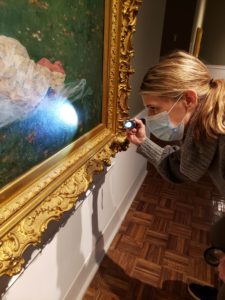
FIA’s Collections Manager, Heather Jackson, peers over every piece of art in the collection.
As the FIA’s Collections Manager, Jackson oversees the vast art collection to note any changes in an art piece’s condition, including the frame, stand or pedestals attached to or supporting the art, and makes sure each one is reported and resolved.
“I take the job very seriously,” she says, moving her hands with magnifying glass and flashlight in straight horizontal motions from right to left — a process she uses to examine each painting and work of art.
Jackson enters each condition report into a software program called Articheck

Albert-Emile Artigue’s Spring Flowers painting displayed in the Johnson Gallery at The Flint Institute of Arts. (Photo by Tom Travis)
Standing ten feet back from the painting, the average art gallery patron might say the painting looks perfect, beautiful and all together lovely. But Jackson has a sharper eye.
“I’m looking for chipping, bumps, and flaking” among other types of damages that may not be visible in normal gallery lighting, she explains.
Jackson, 42, says her role as collections manager is to “care for the collection.”
“With the works that are on view I like to do regular reviews see if there’s any differences in the conditions or if major issues that have come up. Even though we have a controlled environment [temperature, humidity and light] you can have issues come up from the medium, frame and supports for the works of art. There are a lot of things that you really can’t control even in a controlled environment. So I do regular checks to see if there are any differences.”
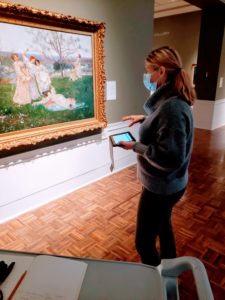
Heather Jackson, Collections Manager at FIA, holds her tablet as she explains condition reporting on works of art. (Photo by Tom Travis)
“It’s more common to find existing issues,” she says, “and the most common thing I find is that a preexisting condition may have slightly changed.
“That’s not a huge issue, but when you start to see a change like a some of the paint begins to pucker or bubble — If that begins to happen, I would photograph it and consult with the conservator” who would then make the necessary fixes if needed.
FIA does not have a conservator on staff. They use Detroit-based conservator Kenneth B. Katz; his business is Conservation and Museum Services.
FIA follows “industry standards” for gallery climate control and “We keep everything within that realm,” Jackson explains. A “micro-climate” can be created for some paintings and art work closed frames or glaze for added protection.
Jackson says oil paints are more durable than acrylic paints because they are water-soluble. She added it depends if a painting is on paper versus canvas. Jackson also conducts condition reporting on the sculpture work and glass work.
Standing in front of the acclaimed John Singer Sargent painting Garden Study of the Vickers Children, Jackson said that it is common, especially in paintings from the 18th and 19th centuries, while conducting a condition report to find things that need to be repaired or at least noted and for possible future repairs.
Jackson noted that “fortunately” the FIA has not had a lot of issues with works of art being damaged intentionally or accidentally by the public. A brown line on the floor in front of most the gallery’s paintings or signs on the floor and wall advise the public “do not touch” the works or art.
“There was a school group visiting years ago and a piece of a frame fell off. but I don’t think it was because someone touched it. As I recall, the frame was already kind of loose and it was immediately repaired,” Jackson recalls.
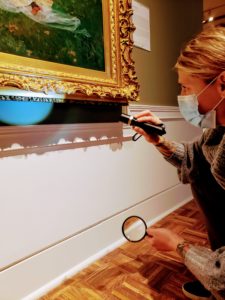
Heather Jackson, Collections Manager at FIA, examines the frame of one of the many 19th-century paintings. (Photo by Tom Travis)
Many of the frames are ornate, gold-gilded, and they need as much conservation as the paintings, Jackson says. On the particular frame pictured above, she points out that it’s plaster mold and will need to be replicated then gilded.
Gilding is “a pretty involved process,” Jackson says. The conservator that FIA uses to repair works of art does not personally repair frames, but he has someone on staff that can do it.
Jackson says she couldn’t comment on the prices associated with the art work in the FIA collections for insurance purposes, but explains that one of “the most appreciated and beloved pieces is the John Singer Sargent painting Garden Study of the Vickers Children.
“It is one of our jewels of the collection,” she exclaims.
Jackson explains that she tries to review regularly the works that are “staples” in the gallery and many of the galleries” do not change fairly regularly” what’s on display.
To those who might think that Jackson’s job is boring, she responds, “My job, condition reporting, is often not known or misunderstood and overlooked because it is not as glamorous or it’s not as frequently seen. My job, to me, is very interesting, it changes every day.
Heather Jackson, collections manager at the Flint Institute of Arts, stores a robe in the FIA’s textile collection with a special paper intended to absorb acidity and preserve the material. (Photo source: FIA)
“Today I’m doing condition reporting, tomorrow I may be in the print library, rehousing textiles and other collections, working with archival material, the next day I may be taking installation photographs of new gallery exhibitions. So my duties change fairly regularly. To me it’s very interesting.”
Jackson also conducts condition reports on works of art that are shipped to FIA for exhibit. She does a condition report at the beginning when the art work is unpacked and again when the art work is packaged and shipped out.
Jackson says she also does condition reporting on the vast glass collection housed in the new Sherwin and Shirley Glass gallery. “That was a learning process for me, learning about issues with glass. It’s been educational for me.”
Jackson, a Grand Blanc resident, has been at the FIA for 11 years and in the role as Collections Manager for two years. “I’ve been doing condition reporting since my second or third year here. But as I’ve been here longer, my responsibilities have changed towards collections management.” She has a B.A. in Art and Art History from Wayne State University.
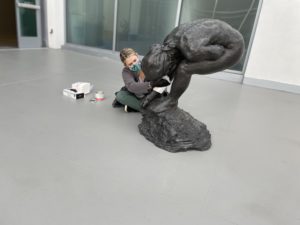
Heather Jackson, collections manager at the Flint Institute of Arts, applies a coat of butcher’s wax to Eric Fischl’s Untitled: Woman Bending sculpture in the Hurand Sculpture Courtyard. (Photo source: FIA)
Jackson says she and FIA Registrar Peter Ott both regularly wax the bronze sculptures in the outdoor courtyard to protect them due to exposure to the elements.
The FIA website describes the process of a recent waxing of sculptures in the Hurand Sculpture Courtyard. “Heather Jackson, collections manager at the Flint Institute of Arts, recently completed waxing one of the FIA’s bronze sculptures that is currently displayed in the Hurand Sculpture Courtyard. Butcher’s wax, recommended by conservators, is used on the sculptures to preserve the condition of the work.
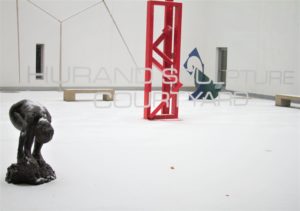
The Hurand Sculpture Garden at the Flint Institute of Arts. (Photo by Tom Travis)
“Bronze can last indefinitely, but exposure to chemicals, temperatures, and human contact can cause deterioration. Oxidation refers to the chemical reaction of copper with the elements, which causes the color to change over time. Preventative measures are particularly important to slow down that process.
“We wax our bronze sculptures approximately yearly,” Jackson said. “Exposure to the elements can cause our outdoor sculptures to oxidize. The waxing process helps prevent condition issues, such as bronze disease and keeps the appearance of the work as the artist intended.”
“Slowing down that process is vital, because if oxidation gets out of the realm of a preventative measure, a conservator would have to come in and recommend a course of action for restoration, which typically has an expensive cost associated with it,” according to the FIA website.
Additional information on conservation of tapestries and other art work at the FIA can be found at this link: The Rinaldo and Armida tapestries in the Viola Bray Renaissance Gallery underwent conservation treatment in 2019. The FIA website explains that conservation process at this link flintarts.org/art/conservation.
The FIA has approximately 160,000 visitors per year and about 1,700 students from preschool to adult who take classes each year, according to Patrick Hayes, the FIA’s communication and marketing coordinator.
EVM Managing Editor Tom Travis can be reached at tomntravis@gmail.com

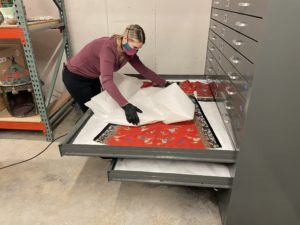

You must be logged in to post a comment.